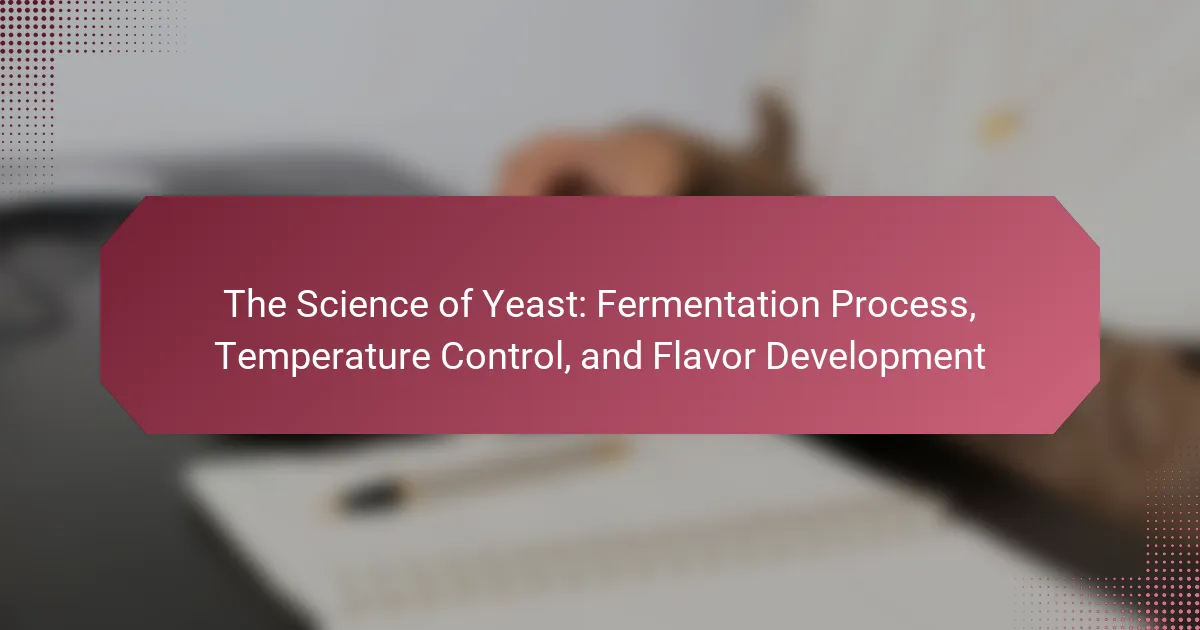Yeast, specifically Saccharomyces cerevisiae, is a single-celled fungus vital for fermentation, converting sugars into alcohol and carbon dioxide. This process is essential for producing alcoholic beverages, bread, and other fermented foods. Key factors influencing fermentation include temperature, pH levels, oxygen availability, nutrient availability, yeast strain, and fermentation time, all of which impact yeast activity and flavor development. The article explores how these factors affect the biochemical processes during fermentation, leading to the production of various flavor compounds and the overall complexity of the final product.

What is Yeast and its Role in Fermentation?
Yeast is a single-celled fungus that plays a crucial role in fermentation. It converts sugars into alcohol and carbon dioxide through the process of anaerobic respiration. This transformation is essential in the production of alcoholic beverages, bread, and other fermented foods. The most commonly used yeast in fermentation is Saccharomyces cerevisiae. This species is known for its efficiency in converting glucose to ethanol. During fermentation, yeast consumes sugars and releases ethanol, which contributes to the flavor and preservation of products. Additionally, carbon dioxide produced by yeast causes dough to rise in baking. Yeast also contributes to the development of complex flavors in beer and wine through various metabolic byproducts.
How does yeast initiate the fermentation process?
Yeast initiates the fermentation process by converting sugars into alcohol and carbon dioxide. This process begins when yeast cells, such as Saccharomyces cerevisiae, are introduced to a sugar-rich environment. The yeast metabolizes the sugars through glycolysis, breaking them down into pyruvate. This pyruvate is then converted into ethanol and carbon dioxide through alcoholic fermentation. The production of carbon dioxide creates bubbles, which is a characteristic of fermentation. This process is anaerobic, meaning it occurs without oxygen. Yeast’s ability to ferment sugars is fundamental in brewing and baking industries. The temperature and pH levels significantly influence yeast activity and fermentation rates.
What are the different types of yeast used in fermentation?
The different types of yeast used in fermentation include Saccharomyces cerevisiae, Saccharomyces pastorianus, and Brettanomyces. Saccharomyces cerevisiae is the most common yeast for baking and brewing. It ferments sugars into alcohol and carbon dioxide efficiently. Saccharomyces pastorianus is used primarily in lager beer production. It ferments at lower temperatures, resulting in a clean taste. Brettanomyces is a wild yeast that adds complex flavors to certain beers and wines. Each type of yeast has unique fermentation characteristics and flavor profiles.
What are the key characteristics of yeast that influence fermentation?
Yeast characteristics that influence fermentation include strain type, sugar metabolism, and temperature tolerance. Different yeast strains, such as Saccharomyces cerevisiae, exhibit unique fermentation abilities. Sugar metabolism varies among strains, affecting alcohol and carbon dioxide production. Yeast also requires specific temperatures for optimal activity. Most yeasts ferment best between 20°C and 30°C. Higher temperatures can lead to off-flavors and stress the yeast. Additionally, yeast’s ability to flocculate impacts the clarity and quality of the final product. These characteristics collectively determine the efficiency and outcome of the fermentation process.
Why is yeast considered a microorganism?
Yeast is considered a microorganism because it is a single-celled organism that cannot be seen with the [censured] eye. Yeast belongs to the kingdom Fungi and is classified as a eukaryotic microorganism. Eukaryotic cells contain a nucleus and other organelles, distinguishing them from prokaryotic cells like bacteria. Yeast cells typically range from 3 to 40 micrometers in size. They reproduce asexually through a process called budding. This microscopic size and unicellular nature confirm its classification as a microorganism. Yeast plays a crucial role in fermentation, converting sugars into alcohol and carbon dioxide. This process is vital in baking and brewing industries.
What are the biological functions of yeast during fermentation?
Yeast performs several biological functions during fermentation. Primarily, it converts sugars into alcohol and carbon dioxide through the process of glycolysis and alcoholic fermentation. This conversion occurs when yeast metabolizes glucose, producing ethanol as a byproduct. Additionally, yeast contributes to the development of flavor compounds and aromatic substances, enhancing the sensory profile of fermented products. Yeast also plays a role in the production of organic acids, which can influence the acidity and preservation of the final product. Furthermore, yeast helps in the clarification of beverages by flocculating and settling after fermentation. These functions are essential in brewing, winemaking, and baking, showcasing yeast’s importance in various fermentation processes.
How does yeast reproduction affect fermentation outcomes?
Yeast reproduction significantly influences fermentation outcomes. The primary method of yeast reproduction is budding, where a mother cell produces daughter cells. This process increases the yeast population, enhancing fermentation efficiency. A higher yeast cell count can lead to more rapid sugar conversion into alcohol and carbon dioxide. Additionally, the health and vitality of yeast cells directly impact fermentation speed and flavor profile. Healthy yeast can produce desirable esters and phenols, contributing to the final product’s aroma and taste. Conversely, stressed or insufficient yeast may result in incomplete fermentation and off-flavors. Studies show that optimal yeast cell density can improve fermentation consistency and product quality.

What Factors Influence the Fermentation Process?
The fermentation process is influenced by several key factors. Temperature is crucial as it affects yeast activity and metabolic rates. Optimal temperatures for fermentation typically range from 68°F to 72°F (20°C to 22°C). pH levels also play a significant role; most yeast thrives in a slightly acidic environment, around pH 4 to 5. Oxygen availability impacts fermentation as well. Yeast requires oxygen for growth but switches to anaerobic metabolism during fermentation. Nutrient availability, including nitrogen and sugars, is essential for yeast health and fermentation efficiency. The type of yeast strain used can also influence the fermentation characteristics and flavor profile. Finally, fermentation time affects the development of flavors and aromas, with longer fermentations often resulting in more complex profiles.
How does temperature control impact yeast activity?
Temperature control significantly impacts yeast activity. Yeast functions optimally within a specific temperature range, typically between 20°C to 30°C (68°F to 86°F). At these temperatures, yeast metabolizes sugars efficiently, producing carbon dioxide and alcohol during fermentation.
When temperatures are too low, yeast activity slows down. This can lead to incomplete fermentation and off-flavors in the final product. Conversely, high temperatures can stress yeast, resulting in rapid fermentation that may produce undesirable byproducts.
Research shows that yeast strains exhibit varying tolerance to temperature changes. For instance, some strains may thrive at higher temperatures, while others may become inactive. Maintaining optimal temperature is crucial for achieving desired fermentation outcomes and flavor profiles.
What is the optimal temperature range for yeast fermentation?
The optimal temperature range for yeast fermentation is typically between 68°F to 72°F (20°C to 22°C). Within this range, yeast is most active and efficient in converting sugars into alcohol and carbon dioxide. This temperature supports healthy yeast metabolism and promotes desirable flavor profiles. At temperatures below this range, fermentation slows down, while temperatures above can stress the yeast, leading to off-flavors. Studies indicate that different yeast strains may have slight variations in their optimal ranges, but most align within this specified temperature range.
How do temperature fluctuations affect fermentation results?
Temperature fluctuations significantly impact fermentation results. Yeast activity is highly sensitive to temperature changes. Higher temperatures can speed up fermentation but may lead to off-flavors. Conversely, lower temperatures can slow down yeast activity and result in incomplete fermentation. Optimal fermentation temperatures typically range between 65°F to 75°F for most yeast strains. Deviations from this range can stress yeast and alter the final product’s taste and aroma. Research indicates that consistent temperatures yield more predictable fermentation outcomes. For instance, a study by the American Society of Brewing Chemists found that temperature-controlled fermentation produced superior flavor profiles compared to uncontrolled environments.
What is the significance of pH in fermentation?
pH plays a crucial role in fermentation. It affects yeast activity and fermentation efficiency. Optimal pH levels promote yeast growth and metabolic functions. Most yeast strains thrive in a pH range of 4.0 to 6.0. Outside this range, yeast can become stressed or inactive. Low pH can inhibit the growth of undesirable bacteria. High pH can lead to off-flavors and reduced fermentation rates. Maintaining proper pH is essential for consistent product quality. Studies show that pH adjustments can enhance fermentation performance significantly.
How does pH affect yeast growth and fermentation efficiency?
pH significantly affects yeast growth and fermentation efficiency. Yeast thrives in a specific pH range, typically between 4.0 and 6.0. Outside this range, yeast activity declines. Low pH can inhibit yeast growth, leading to slower fermentation. Conversely, high pH levels can also hinder yeast function. Studies show that optimal pH enhances yeast metabolism and alcohol production. For instance, a pH of around 4.5 promotes maximum fermentation rates. This is crucial in brewing and baking processes. Maintaining the right pH can improve flavor profiles and product consistency.
What methods can be used to monitor and adjust pH levels?
pH levels can be monitored and adjusted using several methods. Common methods include pH meters, pH test strips, and titration. pH meters provide precise measurements and are widely used in laboratories. Test strips offer a quick and easy way to estimate pH levels. Titration involves adding a reagent to a solution until a specific pH is reached.
To adjust pH levels, acids or bases can be added. For example, citric acid can lower pH, while sodium bicarbonate can raise it. Regular monitoring ensures optimal conditions for yeast fermentation. Maintaining appropriate pH levels supports yeast activity and enhances flavor development.

How Does Flavor Development Occur During Fermentation?
Flavor development during fermentation occurs through a series of biochemical processes. Yeast and bacteria convert sugars into alcohol, carbon dioxide, and various flavor compounds. This conversion produces esters, phenols, and organic acids, which contribute to the overall flavor profile. Different strains of yeast and bacteria yield distinct flavors based on their metabolic pathways. Temperature also influences fermentation, affecting the rate of these reactions and the types of compounds produced. For example, higher temperatures may enhance ester production, leading to fruity flavors. In contrast, lower temperatures can produce cleaner, crisper profiles. The complexity of flavor results from the interaction of these compounds during fermentation.
What compounds are produced by yeast that contribute to flavor?
Yeast produces several compounds that contribute to flavor. These compounds include esters, phenols, and higher alcohols. Esters create fruity flavors, such as banana and pear. Phenols can impart spicy or clove-like notes. Higher alcohols add complexity and can enhance mouthfeel. The specific strains of yeast influence the types and amounts of these compounds produced during fermentation. For example, Saccharomyces cerevisiae is known for producing a wide range of flavor-active compounds. Studies show that fermentation conditions, including temperature and oxygen levels, also affect flavor compound production.
How do esters and phenols affect the flavor profile?
Esters and phenols significantly influence the flavor profile in fermentation processes. Esters often contribute fruity and floral notes to beverages. They are formed during fermentation when alcohols react with acids. Common esters include ethyl acetate and isoamyl acetate. These compounds can enhance the overall aroma and taste.
Phenols, on the other hand, impart spicy, smoky, or medicinal flavors. They are derived from the breakdown of certain compounds in yeast and grains. Certain phenolic compounds can also add complexity to the flavor profile. For instance, 4-vinyl guaiacol provides a clove-like aroma.
The balance of esters and phenols is crucial. It shapes the sensory experience of the final product. Different yeast strains produce varying amounts of these compounds. Temperature control during fermentation also affects their concentrations. Higher temperatures typically increase ester production, while cooler temperatures may enhance phenolic flavors.
What role does fermentation duration play in flavor complexity?
Fermentation duration significantly influences flavor complexity. Longer fermentation times allow for more extensive yeast activity. This activity leads to the production of various flavor compounds. These compounds include esters, phenols, and organic acids. Each of these contributes unique flavors and aromas. Research indicates that extended fermentation can enhance depth and richness in flavor profiles. For example, a study published in the Journal of Agricultural and Food Chemistry found that longer fermentation resulted in higher levels of desirable flavor compounds. This evidence supports the idea that fermentation duration is crucial in developing complex flavors.
How can fermentation techniques enhance flavor development?
Fermentation techniques enhance flavor development by allowing microorganisms to break down sugars into alcohol and acids. This process produces a variety of flavor compounds, including esters and phenols. These compounds contribute to the complexity and depth of flavors in fermented products. For example, in beer brewing, yeast fermentation generates fruity and floral notes. In sourdough bread, lactic acid bacteria create tangy flavors. Temperature control during fermentation also influences flavor profiles. Higher temperatures can lead to more esters, while lower temperatures produce cleaner flavors. Studies show that specific strains of yeast can yield distinct flavor characteristics. Thus, fermentation techniques are crucial for achieving desired flavor outcomes in various foods and beverages.
What are the benefits of using different fermentation vessels?
Different fermentation vessels offer distinct benefits that enhance the fermentation process. Each type of vessel can influence temperature control, oxygen exposure, and yeast behavior. For example, glass carboys allow for better visibility and monitoring of fermentation. Stainless steel vessels provide superior temperature control due to their insulation properties. Plastic fermenters are lightweight and easy to handle, making them user-friendly for home brewers.
The choice of vessel can also affect the flavor profile of the final product. Oak barrels impart unique flavors and aromas due to the wood’s interaction with the fermentation process. Additionally, the size and shape of the vessel can impact the surface area exposed to the yeast, influencing fermentation speed and efficiency.
Using different vessels can also facilitate the production of various styles of beverages. For instance, open fermentation vessels are often used for sour beers, allowing wild yeast and bacteria to contribute to flavor. The versatility of fermentation vessels enables brewers to experiment and optimize their processes for desired outcomes.
How does the timing of ingredient additions influence flavor?
The timing of ingredient additions significantly influences flavor development in food and beverages. Early additions allow flavors to meld and intensify during cooking or fermentation. For example, adding spices at the beginning of a cooking process infuses their essence into the dish. Conversely, late additions preserve the fresh, vibrant notes of ingredients. For instance, herbs added at the end of cooking retain their aromatic qualities. In fermentation, the timing of sugar or yeast additions can affect the final flavor profile. Studies show that different stages of ingredient incorporation lead to varying flavor compounds being produced. This demonstrates the critical role timing plays in achieving desired taste outcomes.
What are the best practices for optimizing flavor in fermented products?
The best practices for optimizing flavor in fermented products include careful selection of ingredients, precise temperature control, and monitoring fermentation time. Quality ingredients enhance flavor complexity. Yeast strains significantly influence the final taste profile. Maintaining optimal fermentation temperatures promotes desired flavor compounds. For example, higher temperatures can enhance esters and phenols, contributing to fruity and spicy notes. Monitoring pH levels during fermentation is crucial as it affects flavor development. Regular tasting throughout the fermentation process helps identify the optimal flavor point. Additionally, proper oxygen management during fermentation can improve yeast performance and flavor outcomes. These practices are supported by research indicating that specific fermentation conditions directly impact flavor profiles in products like beer and wine.
The primary entity of this article is yeast, specifically its role in the fermentation process. Yeast, a single-celled fungus, is essential for converting sugars into alcohol and carbon dioxide, impacting the production of various fermented products like bread and beverages. The article explores the fermentation process initiated by yeast, the types of yeast used, and the key factors influencing fermentation, including temperature and pH levels. Additionally, it discusses how yeast reproduction, fermentation duration, and ingredient timing affect flavor development, highlighting best practices for optimizing flavor in fermented products.



